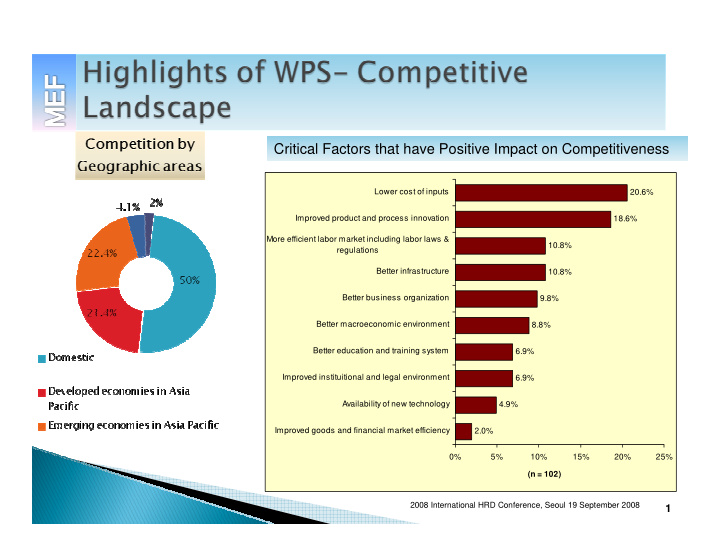



Critical Factors that have Positive Impact on Competitiveness Lower cost of inputs 20.6% Improved product and process innovation 18.6% More efficient labor market including labor laws & 10.8% regulations Better infrastructure 10.8% Better business organization 9.8% Better macroeconomic environment 8.8% Better education and training system 6.9% Improved instituitional and legal environment 6.9% Availability of new technology 4.9% Improved goods and financial market efficiency 2.0% 0% 5% 10% 15% 20% 25% (n = 102) 2008 International HRD Conference, Seoul 19 September 2008 1
� Recruitment Recruitment � � Newly recruited employees constituted 15.5%of workforce of which 6.2%are recruited abroad – shortage or unavailability of special skills � 70.3%respondent companies faced difficulties in recruiting right employees with appropriate skills – key to driving companies competitive advantage � Skills mismatch – call for greater collaborative efforts between industry and academia and compulsory industrial attachment 2008 International HRD Conference, Seoul 19 September 2008 2
Important Factors in Recruitment Recruitment Recruiting Employees Respondent companies reported average of 9.2%of total positions currently unfilled 2008 International HRD Conference, Seoul 19 September 2008 3
� Wages and Benefits Wages and Benefits � No. of Minimum Mean Maximum Resp. Co (RM) (RM) (RM) Management 48 2,000 9,015 30,944 Administration Support Staff 51 723 2,591 6,500 Technical/Professional 46 934 3,903 10,500 Skilled Production/Operation 41 800 1,946 8,000 Semiskilled Production/Operation 34 600 1,298 2,800 Unskilled Production/Operation 29 523 918 1,800 Average Salary Increase (%) No. of Average Resp. Co Management 39 5.1 Administration Support Staff 41 5.4 Technical/Professional 37 6.4 Skilled Production/Operation 33 5.1 Semiskilled Production/Operation 29 4.5 Unskilled Production/Operation 23 4.2 2008 International HRD Conference, Seoul 19 September 2008 4
� Performance Related Payment Performance Related Payment � � 57.8%implemented performance related payment system for non executive employees � 16.7%of total earnings of non executive employees based on performance � Variable component of performance based pay system comprised of: � bonus � incentive payments � merit pay 2008 International HRD Conference, Seoul 19 September 2008 5
� Facilities & Benefits Facilities & Benefits � No. of Average % Resp. Co. of Workforce Paid annual leave 103 100.0 Paid maternity leave 103 100.0 Retirement pension (Employees Provident Fund) 103 100.0 Injury/accident insurance 67 91.4 Health insurance 60 84.3 Medical center (Consultation and Hospitalisation) 62 80.4 Retrenchment/termination benefits 43 76.5 Cafeteria/canteen 50 61.4 Transport or transportation allowance 60 44.1 Housing or housing allowance 38 15.6 Educational allowance for worker's children 31 15.1 Child care center 103 1.9 2008 International HRD Conference, Seoul 19 September 2008 6
� Working Hours Working Hours � Alternative work Time Arrangement Average Weekly Working Hours No. of Minimum Mean Maximum Resp. Co Management 101 39 43 70 Administration Support Staff 103 38 43 65 Technical/Professional 102 38 46 80 Skilled Production/Operation 95 39 48 74 Semiskilled Production/Operation 82 39 48 74 Unskilled Production/Operation 79 40 48 74 2008 International HRD Conference, Seoul 19 September 2008 7
Alternative forms of Work Arrangement Alternative forms of Work Arrangement � Multitasking and multiskilling (76.6% ) allow for greater flexibility in management of business and ability to respond quickly to changing circumstances � Teamwork (74.5% ) introduced at workplace by respondent companies to: � improve productivity � reduce cycle time � generate innovative solutions � J ob rotation implemented by 52%of respondent companies to: � increase interest � improve motivation � facilitate multi- skilling 2008 International HRD Conference, Seoul 19 September 2008 8
Recommend
More recommend